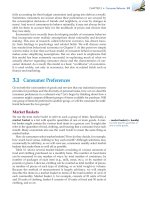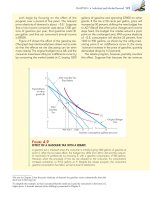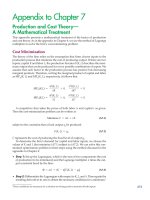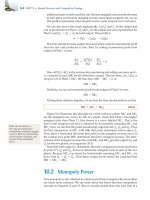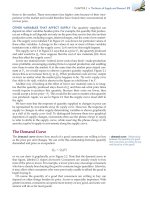(8th edition) (the pearson series in economics) robert pindyck, daniel rubinfeld microecon 121
Bạn đang xem bản rút gọn của tài liệu. Xem và tải ngay bản đầy đủ của tài liệu tại đây (100.27 KB, 1 trang )
96 PART 2 • Producers, Consumers, and Competitive Markets
down an indifference curve in Figure 3.8 (page 79). The additional consumption of food, ⌬F, will generate marginal utility MUF . This shift results in a total
increase in utility of MUF ⌬F. At the same time, the reduced consumption of
clothing, ⌬C, will lower utility per unit by MUC, resulting in a total loss of
MUC ⌬C.
Because all points on an indifference curve generate the same level of utility,
the total gain in utility associated with the increase in F must balance the loss
due to the lower consumption of C. Formally,
0 = MUF(⌬F) + MUC(⌬C)
Now we can rearrange this equation so that
-(⌬C/⌬F) = MUF/MUC
But because −(⌬C/⌬F) is the MRS of F for C, it follows that
MRS = MUF/MUC
(3.5)
Equation (3.5) tells us that the MRS is the ratio of the marginal utility of F to
the marginal utility of C. As the consumer gives up more and more of C to
obtain more of F, the marginal utility of F falls and that of C increases, so MRS
decreases.
We saw earlier in this chapter that when consumers maximize their satisfaction, the MRS of F for C is equal to the ratio of the prices of the two goods:
MRS = PF/PC
(3.6)
Because the MRS is also equal to the ratio of the marginal utilities of consuming
F and C (from equation 3.5), it follows that
MUF/MUC = PF/PC
or
MUF/PF = MUC/PC
• equal marginal principle
Principle that utility is maximized
when the consumer has
equalized the marginal utility
per dollar of expenditure across
all goods.
(3.7)
Equation (3.7) is an important result. It tells us that utility maximization is
achieved when the budget is allocated so that the marginal utility per dollar of
expenditure is the same for each good. To see why this principle must hold, suppose that a person gets more utility from spending an additional dollar on
food than on clothing. In this case, her utility will be increased by spending
more on food. As long as the marginal utility of spending an extra dollar on
food exceeds the marginal utility of spending an extra dollar on clothing, she
can increase her utility by shifting her budget toward food and away from
clothing. Eventually, the marginal utility of food will decrease (because there
is diminishing marginal utility in its consumption) and the marginal utility of
clothing will increase (for the same reason). Only when the consumer has satisfied the equal marginal principle—i.e., has equalized the marginal utility per
dollar of expenditure across all goods—will she have maximized utility. The equal
marginal principle is an important concept in microeconomics. It will reappear in different forms throughout our analysis of consumer and producer
behavior.

